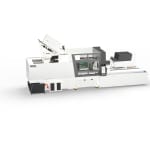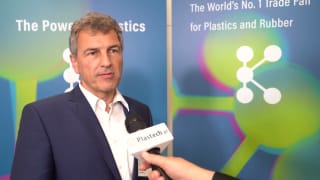
Engel will present an integrated, fully automated production cell for the diagnostics market at K 2025. According to the company, the concept targets an increase in overall efficiency of approximately 25 percent compared to conventional setups by combining moulding and downstream operations in a single, validated cell. The solution produces and packages well plates and matching lids in one system. At its core is an all-electric Engel e-motion 280 WP combi MW injection moulding machine with 2800 kN clamping force. The compact cell architecture is designed around a two-in-one manufacturing principle implemented with Variotwinstack mould technology from Hack Formenbau GmbH. It enables simultaneous production of up to four polystyrene 24-well plates and their lids, supported by a movable centre platen and two injection units that operate in parallel rather than sequentially. The cycle time is 11 seconds, with shot weights of 42.6 grams for the plates and 13.2 grams for the lids. Process measures include an angled arrangement of the moving injection unit to shorten hot runner flow paths, valve gate hot runner injection without a sprue to optimise material usage and avoid weld lines and flow marks, and a multi-stage demoulding strategy with intelligent cooling and part orientation to widen the process window. Integrated Hack moldlife sense sensor technology monitors mould mechanics continuously and supplies data for digitally assisted process validation. The newly designed layout also reduces system height and lowers the footprint by 40 percent, a factor for cleanroom cost efficiency. Handling, laser marking, assembly, stacking and sterile sealing are automated within the cell.
Two machines in one, parallel injection and tooling
The system applies the two-in-one concept by coupling a compact cell layout with Hack’s Variotwinstack high-performance mould. Plates and lids are moulded at the same time, then removed in one step. The movable centre platen supports optimal media connection for the plate geometry, while the dual injection units run in parallel to shorten the cycle. The moving injection unit is positioned at an angle, bringing the nozzle closer to the hot runner to reduce melt volume and improve process robustness. The valve-gated hot runner operates without a sprue, which improves material efficiency and, in this application, eliminates weld lines and flow marks on visible surfaces. Demoulding is executed in multiple stages with targeted cooling and controlled part orientation, contributing to consistent dimensional accuracy and a wide operating window.
Digital validation and condition monitoring
Engel will premiere a validation assistant in this cell for digitally assisted qualification and validation of injection moulding processes. Developed with Hack Formenbau and Professor Thomas Seul, the approach combines Engel iQ assistance systems, moldlife sense data and structured software modules. It is intended to support the full validation sequence from DQ to PQ, accommodate future release methods such as parametric release, and simplify transfer of validated processes to additional machines or production sites. By structuring data capture and decision steps, the assistant aims to reduce time and staffing needs for validation and to shorten time to market. In parallel, continuous condition monitoring via moldlife sense helps increase system availability and detect faults early.

Efficient, cleanroom-compatible production in a compact footprint: Fully automated manufacturing of well plates and lids with an 11-second cycle time on the Engel e-motion 280 combi MW.
Footprint, downstream automation and quality steps
A newly designed layout lowers the overall height and reduces the cell footprint by 40 percent, which can translate into cost savings in cleanroom environments. The e-motion series is positioned for medical technology applications that require high precision, energy efficiency and long-term cleanroom suitability. Downstream of demoulding, a side-entry robot from Ilsemann removes the parts. Two arms grip from both sides of the mould and transfer the parts either to a sampling station or to a laser marking station where a QR code is applied. The plates and lids are then automatically assembled, stacked and sealed in sterile packaging within the cell.

Maximum precision for diagnostics: Well plates with lids, manufactured to meet the highest standards in quality, dimensional accuracy, cleanliness and cost efficiency.
Engel will exhibit the cell at K 2025 in Düsseldorf, Hall 15, stands B42 & C58.




